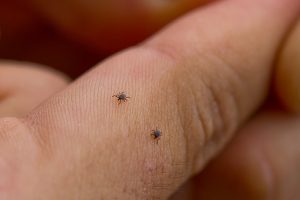
Based on the symptoms, Lyme disease can be easily misdiagnosed with other common ailments, so diagnosis can be quite challenging. What sets Lyme disease apart form other illnesses is a distinct rash, which looks like a bull’s eye target – known as erythema migrans. Another important aspect to consider – and one that doctor’s commonly ask about – is, whether the patient has been to a tick-infested area.
The last notable study conducted on Lyme disease was back in 1998. Since the problem is quickly expanding, the medical community may have forgotten about Lyme disease or may not have had much experience with it, thus contributing to insufficient diagnostics. For this reason, researcher Dr. Rebecca Eisen began studying Lyme disease to better understand the condition and the reason for its prevalence.
Dr. Eisen and her team conducted a survey to establish current distribution of blacklegged ticks and reviewed scientific research available to determine whether the tick distribution has changed.
What Dr. Eisen found was, the blacklegged tick is now in 45 percent of U.S. counties, compared to only 30 percent back in 1998. Expansion is also seen largely through the North, while the Southern states have remained relatively stable. Dr. Eisen said, “This study shows that the distribution of Lyme disease vectors has changed substantially over the last nearly two decades and highlights areas where risk for human exposure to ticks has changed during that time.”
Dr. Eisen suggests stronger surveillance of tick-infested areas in order to monitor expansion and to collect accurate data throughout the years. She concluded, “The observed range expansion of the ticks highlights a need for continuing and enhancing vector surveillance efforts, particularly along the leading edges of range expansion.”
Ticks that feed on birds can increase range of Lyme disease
A previous study found that ticks that feed on birds could explain the expansion of Lyme disease. The researchers found a species of ticks, which although do not bite humans, do bite birds, which can carry these ticks to different regions. If a bird becomes infected by these ticks, and if another human-biting tick feeds off this bird, it can then become infected and transmit the infection to humans.
While studying a variety of birds, the researchers found multiple different ticks feeding on the birds, thus increasing the risk of Lyme disease infection.
The study reaffirms the ecological aspect of Lyme disease as an approach to a better understanding of the disease.
Related Reading:
Chronic Lyme disease symptoms persist even with prolonged antibiotic use: Study
Chronic Lyme disease symptoms persist even with prolonged use of antibiotics, according to the research. In a study, researchers found that 12 weeks of antibiotics treatment was ineffective at combating long-term symptoms of Lyme disease among 280 patients. The study is known as PLEASE, and it is the largest study of its kind to follow patients with chronic Lyme disease symptoms. The study aimed to look at the effectiveness of two antibiotic regimes that were both shown to be ineffective. Continue reading…
Lyme disease-induced inflammation causes nervous system changes, new research
Lyme disease-induced inflammation causes nervous system changes, according to new research. Nearly 15 percent of Lyme disease patients develop peripheral and central nervous system involvement, which is accompanied by painful symptoms. Inflammation plays a role in these neurological changes, but the researchers found that the anti-inflammatory drug dexamethasone prevents many of these reactions. Continue reading…
Sources:
https://entomologytoday.org/2016/01/18/ticks-that-transmit-lyme-disease-reported-in-fifty-percent-of-u-s-counties/
http://jme.oxfordjournals.org/content/53/2/349
https://entomologytoday.org/2015/11/23/a-tick-that-feeds-on-birds-may-increase-the-range-of-lyme-disease/